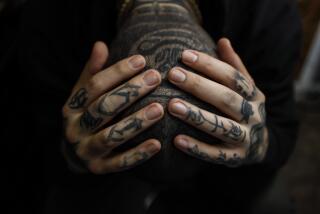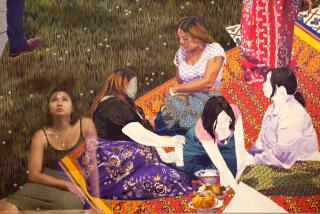ARTISANS : Spotlighting Makers of Handcrafted Goods : With Few Strokes, Chinese Brush-Painters Create Works : Interest Sparked at an Early Age for 30-Year Master
When Jack Liang of Fullerton strokes his brush across a piece of rice paper, several colors emerge: light grays, black, brown, golden yellows, a touch of orange. All with one brush stroke. As a 30-year master of Chinese brush-painting, heâs able to create fluid, smooth lines with just a few strokes.
âChinese brush-painting is quite different from Western styles,â he said. âWith Western painting, each brush stroke tends to be a separate color. With Chinese style, we place the ink on the brush in a particular place and by holding the brush at different angles, we can create a variety of different colors with a single stroke.â
Since arriving in the United States from Taiwan seven years ago, Liang has developed a strong following of those who admire his work or would like to emulate his style. He currently teaches brush-painting at the Fullerton Chinese School (it meets on Saturdays at Sunny Hills High School) and to private students.
His interest in brush-painting was sparked at an early age. His father, Liang Yu Ming, was a well-known artist in their native Taiwan, as were two of his uncles.
âThere were four brothers in my fatherâs family and we owned two acres of land,â Liang said. âEach family had a small house and my father and uncles would get together to paint. My 15 cousins and I were always running around so the men found the best way to quiet us down was to give us some ink and paper.â
Under his familyâs tutelage and later at an art school in Taiwan, Liang learned how to create beautiful images with an economy of brush strokes. Upon arriving in the United States, he found a willing group of pupils eager to learn more about this art form.
âWhat also makes Chinese brush-painting different is that it is not only painting,â he said. âWith one of these paintings, youâll also find poetry, calligraphy, pen work and the artistâs seal.â (The seal is used instead of the artistâs signature commonly used on Western paintings. Each artist puts a great deal of thought into designing a seal.)
Among the guiding principles of Chinese brush-painting are ensuring the piece has life and vitality, creating the painting in a controlled manner, making the form recognizable, choosing the colors carefully, and determining where the image will be placed on the paper.
âWe tend to focus solely on the subject of the painting,â Liang said. âFor instance, with a painting of a woman at a loom, all you will see is the woman and maybe a shadow of the loom to indicate what sheâs doing. There wonât be any background detail at all. With a painting of a fisherman, all youâll see is the man and perhaps a fishing pole. The work is very clean and light without a lot of background details.â
Learning this art form requires a great deal of practice, according to Liang who still sits down each day and practices calligraphy.
âYou need to practice each stroke over and over again,â he said. âSometimes when Iâm demonstrating this style of painting, Iâll be asked how long it takes me to complete a piece. I usually say, âThirty years.â It took me that long to be able to paint as quickly as I can now. Sometimes it seems very easy, but in fact, it does take years to perfect. Iâm still learning and practicing.â
Chinese brush-paintings are supposed to have a calming, soothing effect, according to Liang.
âThe painting itself is a very peaceful process,â he said. âYouâll notice in most Chinese paintings, the colors are pale and muted. We donât use strong colors in this style. When a piece is finished, the artist should feel quiet and comfortable. My students tell me they find this style of painting very relaxing. It takes away angry thoughts.â
Many of the images that Chinese brush-painters present are symbolic. Flowers figure predominantly in many paintings and depending on the flower, a different meaning may be conveyed.
âFor instance, Chinese give many paintings of peonies since these flowers represent wealth,â Liang said. âThe rose signifies love so it is another popular design.â
One of the most popular groupings represents the four seasons: a peony for spring, a lily for summer, a chrysanthemum for autumn and a plum blossom for winter.
Other popular paintings represent figures from daily life: a woman carrying baskets, a Chinese actor, a child throwing a ball. One scene that Liang painted features two women celebrating a birthday. A crane is featured in the foreground. âThe crane is a sign of a long life and good luck,â he said. âFor birthdays, a symbol of a crane is popular.
âMy father always taught me that an artist shouldnât draw only one thing,â Liang said. âYou need to draw everything, whether itâs people, flowers, animals or landscapes.â
To create these images, a Chinese brush-painter needs what are called âthe four treasures.â These include a brush, ink, an ink stone and paper.
Brushes come in a variety of thickness and are made from different sources. Soft-haired brushes are made from sheepâs wool and are used for larger strokes. The hard-hair brushes are made from horse or wolf hair. These are used for the finer, detail work.
Ink is sold in small blocks or sticks. According to Liang, the ink is created from ash and mixed with a small amount of glue to form the stick. When mixed with water, it becomes fluid. Some of the colored inks are also available in a powder form. And each color should have its own separate bowl or tray so the colors arenât mixed.
The ink stone is a small stone bowl used for mixing the ink. A few drops of water are placed in the bowl and then the ink stick is stirred into the water until the ink in the bowl is thoroughly mixed and the color is even. Rice paper is generally used for the brush-paintings and it is placed on a piece of felt while the artist is working. The cloth absorbs the water that comes through the thin, fine paper and prevents the water from spreading across the page. Artists must also exert caution so they donât tear or wrinkle this delicate paper.
âEven the mounting of the painting has to be done carefully,â Liang said. âBecause the paper is so fine, it wrinkles very easily. Most of the time, Chinese brush-paintings are displayed in the traditional way, on a scroll-like mounting.â
As more people become aware of this art form, Liang has found there is more interest.
âOnce the public understands how we create these paintings, they are often very impressed,â he said. âWe find people not only become interested in the painting itself, but in Chinese culture and literature. Since many of the paintings also have a poem with them, they lend themselves to further interpretation.â


